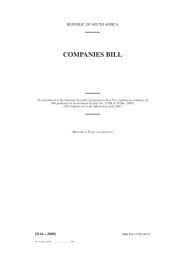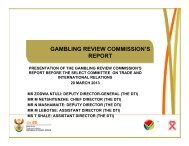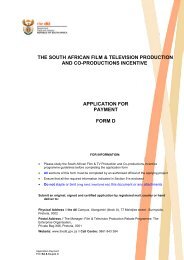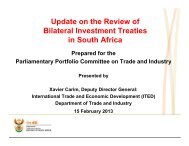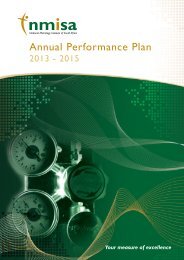Copyright Review Commission Report - ICT Law and Regulation ...
Copyright Review Commission Report - ICT Law and Regulation ...
Copyright Review Commission Report - ICT Law and Regulation ...
- No tags were found...
You also want an ePaper? Increase the reach of your titles
YUMPU automatically turns print PDFs into web optimized ePapers that Google loves.
the relationship between the collecting societies in terms of the frequency of payments, administration fees,interest on cash-on-h<strong>and</strong>, <strong>and</strong> dispute-resolution mechanisms.10.6 FOREIGN DISTRIBUTIONSTable 21: Foreign Distributions versus Foreign CollectionsRefs.Collecting Societies(2010)PRS(UK)SUISA(Swiss)TONO(Norway)EAD(Brazil)IPRS(India)SAMROa.Foreign distributions as% of total distributions26% 38% 49% 23% 5%43% plusinternationalpublishers’componentb.Foreign collections as %of total collections38% 9% 7% 7% 25% 2%10.6.1. SAMRO was not able to provide a complete schedule of the total amount of foreign distributions to the CRCbecause a significant portion of the distributions is paid to the local agents of the foreign publishers (e.g. EMI,Universal <strong>and</strong> Sony).10.6.2. At least 43% of the total distributions for SAMRO are distributed to foreign parties via foreign collectingsocieties. This is due to the fact that the local content targets are too low (25% for commercial radio stations). InSAMPRA‘s case, the situation will not be different when it commences with distribution.10.6.3. With regard to the problem with local content targets, PRIMEDIA’s assessment is as follows:10.6.3.1. English-speaking countries (other than the US) typically have lower levels of consumption of local contentthan those countries with unique languages. So Australia <strong>and</strong> Canada struggle to achieve high levels oflocal content outside of public policy initiatives to develop their domestic music industries, while Brazil orItaly seem to have an easier run of it.10.6.3.2. People like to consume music in their home language or, at the very least, languages they underst<strong>and</strong>.10.6.3.3. Top musicians coming out of the US have a number of advantages, including a massive domestic marketagainst which to amortise investment <strong>and</strong>, as a result, the ability to invest more money in soundrecordings, video <strong>and</strong> concert production, <strong>and</strong> br<strong>and</strong>-building. It is this basic economic structure that allowsfor the emergence of massive global superstars such as Beyoncé <strong>and</strong> Madonna, <strong>and</strong> it is these megastarsagainst whom South African musicians producing in English need to compete. In effect, such SouthAfrican musicians are competing for airtime space against the world’s best <strong>and</strong>, inevitably, have a hardertime than those who are competing for airtime space in a language other than English. Those who producemusic in a language that is restricted to that of their own country have an easier time getting radio <strong>and</strong>consumer attention. There is the immediate cultural affinity of ‘music in an underst<strong>and</strong>able language’coupled with the fact that a considerably smaller group of musicians are competing for airplay in thatlanguage. So, English-speaking countries have a bigger local content battle on their h<strong>and</strong>s than countriesprotected by unique languages, simply because the competitive set is bigger <strong>and</strong> better resourced.- 75 -





